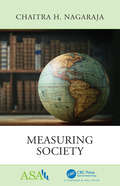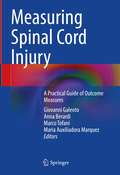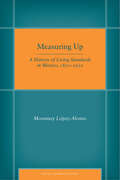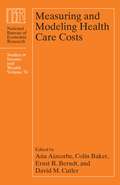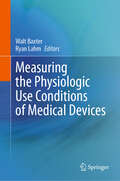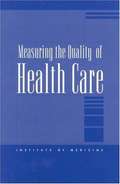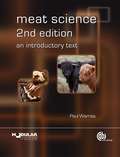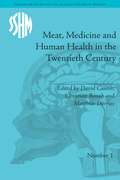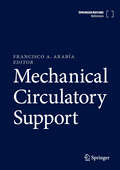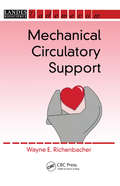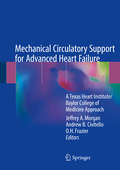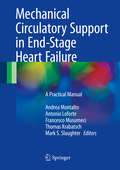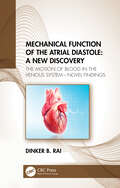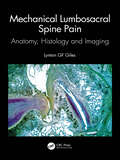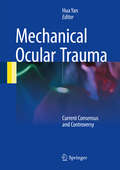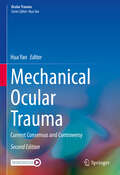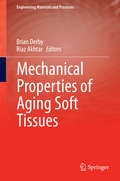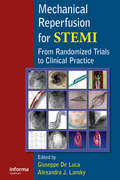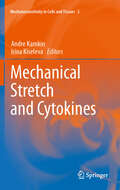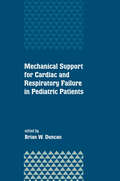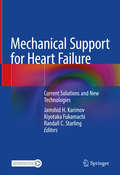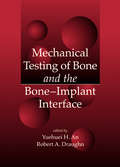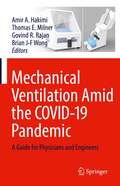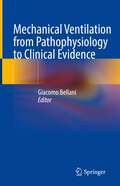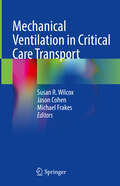- Table View
- List View
Measuring Society (ASA-CRC Series on Statistical Reasoning in Science and Society)
by Chaitra H. NagarajaCollecting and analyzing data on unemployment, inflation, and inequality help describe the complex world around us. When published by the government, such data are called official statistics. They are reported by the media, used by politicians to lend weight to their arguments, and by economic commentators to opine about the state of society. Despite such widescale use, explanations about how these measures are constructed are seldom provided for a non-technical reader. This Measuring Society book is a short, accessible guide to six topics: jobs, house prices, inequality, prices for goods and services, poverty, and deprivation. Each relates to concepts we use on a personal level to form an understanding of the society in which we live: We need a job, a place to live, and food to eat. Using data from the United States, we answer three basic questions: why, how, and for whom these statistics have been constructed. We add some context and flavor by discussing the historical background. This book provides the reader with a good grasp of these measures. Chaitra H. Nagaraja is an Associate Professor of Statistics at the Gabelli School of Business at Fordham University in New York. Her research interests include house price indices and inequality measurement. Prior to Fordham, Dr. Nagaraja was a researcher at the U.S. Census Bureau. While there, she worked on projects relating to the American Community Survey.
Measuring Spinal Cord Injury: A Practical Guide of Outcome Measures
by Giovanni Galeoto Anna Berardi Marco Tofani Maria Auxiliadora MarquezThis book describes validated outcome measures for the international Spinal Cord Injury population. Based on rigorous systematic reviews of ca. 80,000 scientific articles, the authors present assessment tools for various clinical uses in the health sciences, following parameters of validity, reliability, and responsiveness. It is important for the development of clinical practice and research that practical and appropriate measures become universally accepted; this would allow comparisons and meta- analysis of high-quality randomized controlled trials of people with this increasingly common injury. This book emphasizes the need for consensus among researchers as to which tools must be studied in depth or adapted to other national contexts, or which measurement instruments should be standardized in order to develop universal norms and standards for the performance of people with Spinal Cord Injury. It offers a valuable practical guide for clinicians, rehabilitation professionals and nurses, but will also help researchers to gain more confidence in using valid and reliable assessment tools for comparable clinical trials.
Measuring Up: A History of Living Standards in Mexico, 1850-1950
by Moramay Lopez-AlonsoMeasuring Uptraces the high levels of poverty and inequality that Mexico faced in the mid-twentieth century. Using newly developed multidisciplinary techniques, the book provides a perspective on living standards in Mexico prior to the first measurement of income distribution in 1957. By offering an account of material living conditions and their repercussions on biological standards of living between 1850 and 1950, it sheds new light on the life of the marginalized during this period. Measuring Upshows that new methodologies allow us to examine the history of individuals who were not integrated into the formal economy. Using anthropometric history techniques, the book assesses how a large portion of the population was affected by piecemeal policies and flaws in the process of economic modernization and growth. It contributes to our understanding of the origins of poverty and inequality, and conveys a much-needed, long-term perspective on the living conditions of the Mexican working classes.
Measuring and Modeling Health Care Costs (National Bureau of Economic Research Studies in Income and Wealth #76)
by Colin Baker David M. Cutler Ana Aizcorbe Ernst R. BerndtHealth care costs represent a nearly 18% of U.S. gross domestic product and 20% of government spending. While there is detailed information on where these health care dollars are spent, there is much less evidence on how this spending affects health. The research in Measuring and Modeling Health Care Costs seeks to connect our knowledge of expenditures with what we are able to measure of results, probing questions of methodology, changes in the pharmaceutical industry, and the shifting landscape of physician practice. The research in this volume investigates, for example, obesity’s effect on health care spending, the effect of generic pharmaceutical releases on the market, and the disparity between disease-based and population-based spending measures. This vast and varied volume applies a range of economic tools to the analysis of health care and health outcomes. Practical and descriptive, this new volume in the Studies in Income and Wealth series is full of insights relevant to health policy students and specialists alike.
Measuring the Physiologic Use Conditions of Medical Devices
by Walt Baxter Ryan LahmThe physiologic use conditions medical devices are subjected to during implant and long-term in vivo use are critical to ensuring device reliability, efficacy, and safety. This book highlights advanced analyses for measuring the physiologic use conditions of medical devices, introducing important challenges facing engineers. The chapters include: A working definition for the physiologic in vivo use conditions used to further improve medical device performance in patients. Introductions to common approaches used to measure medical device use conditions so that engineers can use similar techniques where useful. Detailed case studies that highlight problem statements, approaches for measuring physiologic use conditions, and example outputs from such analyses. This book provides an up-to-date resource for device engineers so that they can accurately measure conditions that devices experience during and after implantation—key to reliability testing, computational modeling, and choosing optimum designs. This is an ideal book for medical device engineers and scientists designing and manufacturing devices for human use, students interested in understanding how devices interact with anatomy, and academic researchers seeking to apply advanced analyses to unmet use condition needs in the medical device field.
Measuring the Quality of Health Care: A Statement by The National Roundtable on Health Care Quality
by Institute of MedicineA Statement by The National Roundtable on Health Care Quality
Meat Science
by Paul WarrissOutlining the core principles of the subject, this introductory-level textbook covers the production of meat, its structure and chemical composition, meat quality and hygiene, and animal welfare, handling and slaughter. The new edition has been updated to cover significant advances such as the process of conditioning, leading to the tenderisation of meat, and the new coverage of the use of molecular genetic techniques to try to select animals for improved meat quality. Key Features New larger format in two colours throughout Fully revised and updated including new coverage of genomics Carefully selected references and titles for further reading
Meat, Medicine and Human Health in the Twentieth Century (Studies for the Society for the Social History of Medicine #1)
by David Cantor Christian Bonah Matthias DörriesThis collection of essays explores some of the complex relations between meat and health in the twentieth century. It highlights a complicated array of contradictory attitudes towards meat and human health. They show how meat came to be regarded as a central part of a modern healthy diet and trace critiques of meat-eating and the meat industry.
Mechanical Circulatory Support
by Francisco A ArabíaMore than 6 million Americans suffer from heart failure - about 10% of those patients suffer from advanced heart failure. These patients can no longer be treated with conventional heart therapies and symptom management strategies. As a result, a more targeted and invasive technique needs to be discussed and decided between the patient and their doctor. This book describes the current state of the art in mechanical circulatory support with an emphasis in patient selection, device selection, management of comorbidities and complications. The book is the first authoritative and comprehensive volume dedicated to how the technology can be used safely to benefit ill patients suffering from advanced heart failure.The book begins with a brief historical perspective of the technology and its development. It will be divided in 6 sections with multiple chapters, each addressing a specific area in MCS. These sections include types of support, the MCS program, patient selection, operative techniques, management, complications, and special considerations. Chapter authors are experts in their fields. Mechanical Heart Assistance to Heart Replacement: A Guide is an essential reference for all providers (physician, nurses, coordinators, engineers, industry, hospitals and regulatory agencies) who manage patients with advanced heart failure who require mechanical circulatory support.
Mechanical Circulatory Support (Handbooks Ser.)
by Wayne E. RichenbacherThis book is a concise, portable handbook that focuses on the clinical use of mechanical blood pumps. All aspects of mechanical circulatory support are addressed, including patient selection, preoperative preparation, operative management, anesthetic considerations and conduct of cardiopulmonary bypass, postop management including complications associated with blood pump use and long-term care and rehabilitation.
Mechanical Circulatory Support for Advanced Heart Failure
by Jeffrey A. Morgan Andrew B. Civitello O. H. FrazierThis book provides the most up to date information on every aspect of clinical care relating to patients with advanced heart failure who require mechanical circulatory support as a treatment strategy. The book begins with an extensive description of the preoperative patient selection process as well as preoperative medical optimization, including bridge to bridge strategies with short-term devices. The book then transitions into a description of a variety of surgical implantation techniques with special considerations for reoperative surgery. A chapter on intraoperative anesthesia management is specifically focused on intraoperative issues relating to MCS patients. Subsequent chapters focus on perioperative management as well as long-term management of patients on MCS, including optimization of a patient's LVAD speed. A dedicated chapter on the diagnosis of device thrombosis as well as surgical techniques and outcomes associated with device exchanges is also included. The book also summarizes the national and international outcomes data for using MCS as a bridge to transplant and destination therapy. There is also a chapter on the utility of stem cells as an adjunct technique for inducing myocardial recovery. Finally, the book has chapters on complications of MCS, management of right ventricular failure, and the future of MCS.
Mechanical Circulatory Support in End-Stage Heart Failure
by Andrea Montalto Antonio Loforte Francesco Musumeci Thomas Krabatsch Mark S. SlaughterThis book is a detailed practical guide to the use of ventricular assist devices and total artificial hearts to provide mechanical circulatory support (MCS) in patients with end-stage heart failure. It explains why MCS may be indicated, which patients require MCS, when and how to implant ventricular assist devices or a total artificial heart, and how to avoid potential complications of MCS. Management throughout the period of care is described, from preimplantation to follow-up, and both typical and atypical cases are discussed. The text features numerous helpful tips and tricks relating to surgical and nonsurgical management and is supported by a wealth of high-quality illustrations that document preoperative evaluation and implantation technique. Heart transplantation remains the gold standard for the treatment of patients suffering from end-stage heart failure, but the shortage of donors has led to an increase in the use of MCS. This book will assist all physicians, and especially cardiologists and anesthesiologists, who are involved in the care of these patients.
Mechanical Function of the Atrial Diastole: The Motion of Blood in the Venous System—Novel Findings
by Dinker B RaiA recording of new discoveries based on experimental findings, this monograph is dedicated to examining the function of the atrial diastole of the human heart. The comprehensive and well-illustrated Mechanical Function of the Atrial Diastole explores the origins and history of circulation and links them to current newly discovered findings of the motion of blood in the venous system. Complementing the work of Sir William Harvey who discovered the mechanical function of the ventricles, this book examines the mechanical functions of the atrial chambers and completes the function of the human heart. Opening new doors in the world of research to a better understanding and treatment of ailments affecting the human heart, this book will particularly interest vascular surgeons, angiologists, cardiovascular disease specialists and cardiac surgeons as well as those specialists devoted to blood circulation. From the Forewords "The author has made a most ambitious and formidable undertaking of compiling this book and presenting his discovery. His concept is very credible and adds to the present available concept and theory of venous circulation, venous valve movement and atrial relaxation. This book provides a comprehensive text on new concepts and basic understanding of the physiology of venous circulation which will be useful in the diagnosis and treatment of venous diseases." Professor Kailash Prasad "The book is eminently readable with interesting tidbits and anecdotes. For example, we learn that Sir William Harvey softened his theory of circulation to mollify adherents of Galen; Alas, to no avail, as he had to hide for two years for fear of assassination by Galen’s enraged followers. The book is decorated with the author’s original drawings rendered beautifully with his annotations in near Calligraphic precision." Seshadri Raju M.D., FACS. About the Author Dinker Belle Rai is a Board Certified Indian American vascular surgeon who served as the Past Chairman of the Department of Surgery and as the Chief of the Department of Vascular Surgery / Vascular Laboratory at the Interfaith Medical Center, Brooklyn, New York. He is credited with developing the first ever method for retrograde catheterization of the venous tree as well as with the discovery of the motion of venous valves in human beings. In addition to that, his original research on histopathological specimens of patients with saphenofemoral resulted in a paradigm shift in management of varicose veins. He also performed the first ever vein transplantation below the knee. The discovery of right atrial mechanical function is a pivotal discovery in his medical research work.
Mechanical Lumbosacral Spine Pain: Anatomy, Histology and Imaging
by Lynton GF GilesThis book addresses an extremely prevalent medical problem: low back pain. It is not a general anatomy book, but it relates specifically to the lumbosacral spine, encompassing anatomy, histology, histopathology, and imaging all in one volume. For students, the text incrementally introduces them to lumbosacral anatomy terms and scientific knowledge by using photographs of gross and histological sections of the spine, as well as schematic drawings and images, in preparation for clinical practice. It answers many questions about the pathogenesis of low back pain, helpful for clinicians, both for treatment decisions and for counselling patients.Key features: Provides a clear explanation for many of the pain generators in low back pain and illuminates this perplexing and ubiquitous problem Addresses a gap in the existing literature, as 'non-specific' or mechanical lumbosacral spine pain accounts for by far most chronic spinal pain sufferers’ complaints for clinicians from general medical practitioners to spinal specialists in various fields such as sports medicine who deal with spinal pain syndromes Illustrates anatomical structures that can be injured and thus become responsible for causing mechanical lumbosacral spine pain; frequently, such injuries cannot be detected on sophisticated imaging such as MRI
Mechanical Ocular Trauma
by Hua YanThis book provides state-of-the-art information for ophthalmologists and other clinicians facing tough cases, helping them to make the most appropriate decision concerning the management of patients who have suffered mechanical ocular trauma. The discussion of mechanical ocular trauma addresses various parts of the eye: each chapter discusses a certain part of the eye, supplemented by illustrative sample cases. Though the latest consensus is provided for each topic or case, different opinions on controversial topics will also be discussed in detail. Pearls of advice at the end of each chapter highlight its main points. Topics covered include: Traumatic cataract and the timing of surgery and IOL implantation, Traumatic hypotony, Traumatic glaucoma, Timing of vitrectomy after primary repair, Use of silicone oil in traumatic eyes, Intraocular Foreign Bodies, Traumatic endophthalmitis, and much more. As a topic-based clinical reference work on mechanical ocular trauma bringing together consensus and controversies, the book offers useful and attractive information for ophthalmologists.
Mechanical Ocular Trauma: Current Consensus and Controversy (Ocular Trauma)
by Hua YanThis book provides state-of-the-art information for ophthalmologists and other clinicians facing tough cases, helping them to make the most appropriate decision concerning the management of patients who have suffered mechanical ocular trauma. The discussion of mechanical ocular trauma addresses various parts of the eye: each chapter discusses a certain part of the eye, supplemented by illustrative sample cases. Though the latest consensus is provided for each topic or case, different opinions on controversial topics will also be discussed in detail. Pearls of advice at the end of each chapter highlight its main points. Topics covered include: Traumatic cataract and the timing of surgery and IOL implantation, Traumatic hypotony, Traumatic glaucoma, Timing of vitrectomy after primary repair, Use of silicone oil in traumatic eyes, Intraocular Foreign Bodies, Traumatic endophthalmitis, and much more. As a topic-based clinical reference work on mechanical ocular trauma bringing together consensus and controversies, the book offers useful and attractive information for ophthalmologists.In this second edition, authors update hot topics in mechanical ocular trauma, including traumatic glaucoma, traumatic cataract, traumatic vitreoretinal diseases, traumatic macular hole, and also imaging applications in ocular trauma.
Mechanical Properties of Aging Soft Tissues
by Brian Derby Riaz AkhtarExploring the structure and mechanics of aging soft tissues, this edited volume presents authoritative reviews from leading experts on a range of tissues including skin, tendons, vasculature and plantar soft tissues. It provides an overview of in vivo and in vitro measurement techniques including state-of-the-art methodologies, as well as focusing on the structural changes that occur within the main components of these tissues resulting in detrimental mechanical property changes. It also highlights the current challenges of this field, and offers an insight into future developments. Age-related changes in the mechanical properties of soft tissues have a profound effect on human morbidity and mortality, and with changing global demographics, there is growing interest in this area. There has been increasing interest in robustly characterizing these mechanical changes to develop structure-property relationships, and growing awareness of the need for enhanced predictive models for computational simulations. This book seeks to address the challenges involved in applying these engineering techniques to reliably characterize these tissues. Focusing on a wide range of tissues and presenting cutting-edge techniques, this book provides an invaluable reference to academics and researchers in a range of disciplines including biomechanics, materials science, tissue engineering, life sciences and biomedicine.
Mechanical Reperfusion for STEMI: From Randomized Trials to Clinical Practice
by Giuseppe De Luca Alexandra J. LanskyAs a leading cause of death in developed countries, ST-segment elevation myocardial infarction and its various treatment options are of great concern to those in the cardiology field. This text presents evidence-based chapters that supply clinicians with real-life situations and strategies to treat STEMI patients more effectively and at a quicker p
Mechanical Stretch and Cytokines
by Irina Kiseleva Andre KamkinThis book presents the latest findings in the field of investigation of molecular mechanisms of mechanical stretch and the role of cytokines in response of different tissues to it. On the one hand this Volume demonstrates how mechanical stretch enhances cytokines production. It describes how cytokines influence tissues and cells on a background of a mechanical stretching. It provides a description of how cells in different tissues are activated by stretch and cytokines via various signaling pathways, and how they change their gene expression. The book is a unique collection of reviews outlining current knowledge and future developments in this rapidly growing field. Knowledge of biomechanics, and mechanisms which underlie it on molecular, cellular and tissue, is necessary for understanding of the normal functioning of living organisms and allows to predict changes, which arise due to alterations of their environment.
Mechanical Support for Cardiac and Respiratory Failure in Pediatric Patients
by Brian DuncanAnswering the demand for acomprehensive, all-purpose volume focusing on the challenging needs of pediatric patients, Mechanical Support for Cardiac and Respiratory Failure in Pediatric Patients summarizes a wealth of knowledge on the mechanical devices, clinical management, alternative applications, and future directions in the specialized field of
Mechanical Support for Heart Failure: Current Solutions and New Technologies
by Jamshid H. Karimov Kiyotaka Fukamachi Randall C. StarlingThis book provides a comprehensive overview of mechanical circulatory support of the failing heart in adults and children. The book uniquely combines engineering knowledge and the clinician’s perspective into a single resource, while also providing insights into current and future development of mechanical circulatory support technology, such as ventricular assist devices, the total artificial heart and catheter-based technologies for heart failure. Topics featured in this book include:The history of mechanical circulatory device development. Fundamentals of hemodynamics support. Clinical management of mechanical circulatory devices. Surgical implantation techniques. Current limitations of device therapies in advanced heart failure. Advanced and novel devices in the development pipeline. Opportunities for advancement in the field. Mechanical Support for Heart Failure: Current Solutions and New Technologies is a must-have resource for not only physicians, residents, fellows, and medical students in cardiology and cardiac surgery, but also clinical and basic researchers in biomedical engineering with an interest in mechanical circulatory support, heart failure, and new technological applications in medicine.
Mechanical Testing of Bone and the Bone-Implant Interface
by Yuehuei H. An Robert A. DraughnThe mechanical properties of whole bones, bone tissue, and the bone-implant interfaces are as important as their morphological and structural aspects. Mechanical Testing of Bone and the Bone-Implant Interface helps you assess these properties by explaining how to do mechanical testing of bone and the bone-implant interface for bone-related research
Mechanical Ventilation Amid the COVID-19 Pandemic: A Guide for Physicians and Engineers
by Amir A. Hakimi Thomas E. Milner Govind R. Rajan Brian J-F WongThe surge in COVID-19 cases leading to hospitalizations around the world quickly depleted hospital resources and reserves, forcing physicians to make extremely difficult life-or-death decisions on ventilator allocation between patients. Leaders in academia and industry have developed numerous ventilator support systems using both consumer- and industry-grade hardware to sustain life and to provide intermediate respiratory relief for hospitalized patients. This book is the first of its kind to discuss the respiratory pathophysiology underlying COVID-19, explain ventilator mechanics, provide and evaluate a repository of innovative ventilator support devices conceived amid the pandemic, and explain both hardware and software components necessary to develop an inexpensive ventilator support device. This book serves both as a historical record of the collaborative and innovative response to the anticipated ventilator shortage during the COVID-19 pandemic and as a guide for physicians, engineers, and DIY'ers interested in developing inexpensive transitory ventilator support devices.
Mechanical Ventilation from Pathophysiology to Clinical Evidence
by Giacomo BellaniThis book aims to give a comprehensive overview of the current challenges and solution posed to the health care professionals who need to use mechanical ventilation to treat their patients.Mechanical ventilation is a cornerstone of the treatment of critically ill patients, as also dramatically underlined by the recent COVID-19 pandemic. The topic is not simple to approach, since it requires integration of multiple data which, in turn, result from complex interplays between patient’s condition and ventilatory settings. While technological development empowered advanced monitoring and decision support, these also increase the burden of data on the practitioners. Furthermore, considering that sometimes mechanical ventilation is seen under two, apparently opposite, approaches, “physiology vs. protocols”, the book aims to reconcile these two aspects. And this has been done by each author following the above trajectory in their chapters. The exposure of the topic begins from the “pathophysiology” (i.e. the “physiology of the disease”) so that the reader can better understand the concept and rationale of any given approach. At the same time, any rationale or hypothesis (for as much as supported by physiology) must hold at the proof of clinical research and evidence, which is summarized in each chapter.In summary, the purposes is that the readers understand not only which is the best clinical practice to adopt but also why and which mechanisms this is based upon and how to approach a novel issue they might encounter. The book – addressed to physicians, nurses and respiratory therapist – features chapters on “novel” or “hot” topics like, obviously, COVID-19, ECMO, but also MV in low resource setting.
Mechanical Ventilation in Critical Care Transport
by Jason Cohen Susan R. Wilcox Michael FrakesThis book focuses on managing mechanical ventilation and its impact on physiology, primarily in the transport environment. Mechanical ventilation is one of the most common procedures in all critical care, including critical care transport. Yet the management of ventilation poses significant risks to the patient. In the transport environment, understanding the nuances of mechanical ventilation and its impact on physiology is extremely important. Respiratory therapists and critical care physicians are essential critical care team members, but they may not be available in austere or remote locations, and consultation may not always be practical. More than ever, transport clinicians are responsible for managing ventilators according to evidence-based principles. The objectives of this text are to: Familiarize transport clinicians with common terms in mechanical ventilation, Review key principles of pulmonary physiology relevant to both mechanical ventilation and specific to transport, Understand the interpretation of blood gases as related to the management of the ventilated patient, Discuss the basic principles of selecting ventilator settings, Develop strategies for caring for ventilated patients with ARDS, asthma, COPD, trauma, and neurologic injury, Provide information specific to caring for ventilated neonates and pediatric patients, Assess and respond to emergencies during mechanical ventilation. The book closes with a chapter of case studies, which are used to review the principles taught throughout the rest of the text, and a conclusion that neatly sums up the essential points of the book. Chapters are enhanced with diagrams, tables, illustrations, and photographs. All transport clinicians, including experienced nurses, paramedics, emergency medicine residents, physician assistants, nurse practitioners, and EMS fellows will find this book to be of great use. Additionally, clinicians who provide emergency care for ventilated patients outside the critical care transport setting, including paramedics, emergency nurses, emergency physicians, and hospitalists will find this text valuable.
